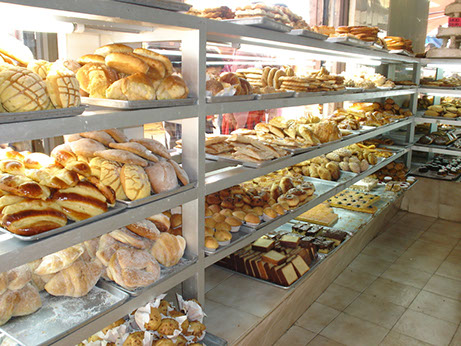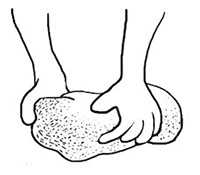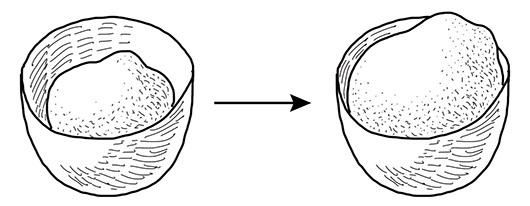The Sensational Single Cell
RETIRED BETA VERSION - For current versions of the SciGen materials, please visit serpmedia.org/scigen
 Introduction to the Issue, Focus Words
Introduction to the Issue, Focus Words
READER'S THEATER
In his mother’s panaderia or bakery, Trey is showing his friends Vanessa, Sarah, and Tim how to bake bread.
Trey: You can put in all kinds of things in bread: eggs, milk, honey, herbs, nuts, raisins, whatever. But this time we’ll use a really basic recipe. Three cups of flour, two teaspoons of salt, two teaspoons of baker’s yeast, and a little over one cup of water. You mix it all together like this.
Sarah: This dough is really sticky.
Trey: Yeah, let’s add a little more flour to make it easier to handle. There, that’s good. Okay, yeast, up and at ’em!
Tim: What is yeast, anyway?
Vanessa: It’s the magic ingredient that makes the bread dough come alive and rise, or puff up.
Sarah: No way! There’s no such thing as magic. But it’s true that the yeast comes alive.
Trey: Yes, the packet of yeast we put in the bread dough has millions of living individuals. They’re each microscopic—too small to see without a microscope.
Tim: Hold on. We’re putting animals in the dough and then baking it? But I’m a vegetarian!
Trey: No, yeast isn’t an animal. It’s an organism—a living thing. But organisms include other things besides animals. Plants and bacteria, for instance. Yeast is a fungus, like mushrooms and mold.
Vanessa: Ew!
Sarah: Like all those things, yeast is just a bunch of little, living cells.
Vanessa: Cells?
Sarah: Yeah, cells. Each human being is made of trillions and trillions of cells, but some microscopic organisms are made of only one cell. Yeast is like that. Each separate yeast cell just lives its own separate little yeasty life as an individual.
Trey: Right. The yeast cells in the bread dough use the flour as a food source. As they eat, they’re able to grow and make more of themselves. They multiply. That's called reproduction.
Sarah: But they also need to get rid of waste that is left over from the food they eat — carbon dioxide gas. And that has a lot to do with how yeast makes the dough rise.
Trey: You’ll see. Now, we’ve got lots to do. Let’s divide up the work. Tim, you grease the pans. Vanessa, you knead.
Vanessa: [long pause] What do I need? Another ingredient?
 Trey: What? Oh, no, not “need.” Knead: K, N, E, A, D. It’s got a silent K. It means squish, press, and fold the dough, to make it the right texture. See, you sprinkle a little flour on the countertop to keep the dough from sticking, then you put the dough there and press it like this… We’ll all take turns.
Trey: What? Oh, no, not “need.” Knead: K, N, E, A, D. It’s got a silent K. It means squish, press, and fold the dough, to make it the right texture. See, you sprinkle a little flour on the countertop to keep the dough from sticking, then you put the dough there and press it like this… We’ll all take turns.
Vanessa: My hands are already tired. Why do we have to knead the dough for so long?
Trey: Kneading makes the dough more flexible and stretchy, which makes it better at trapping the tiny bubbles of carbon dioxide gas that the yeast cells make. Those bubbles are what will give the bread its spongy texture once it’s baked.
Sarah: Okay, it’s been ten minutes, can we bake the dough yet?
Trey: No. Now we have to let it rise. The yeast works best when it’s in a warm place.
Trey puts the dough in a bowl, covers it with a clean kitchen towel, and puts it in a warm spot on the kitchen counter. Then the four friends leave the bakery and go for a walk. An hour and a half later, they come back to check on the dough.
 Vanessa: Wow! The dough has gotten twice as big.
Vanessa: Wow! The dough has gotten twice as big.
Tim: How is that possible?
Trey: Like I said, the yeast makes the dough puff up. The yeast cells all keep puffing up the dough with bubbles of carbon dioxide gas. That’s what it means for bread dough to rise. Given time, they reproduce or multiply—they make more of themselves—making more yeast cells that make more bubbles.
Vanessa: That’s amazing! It really does seem like magic. Could we let it keep going, for days, until the dough grew large enough to feed thousands of people? With enough time, yeast could solve the problem of world hunger!
Trey: Wait a minute—
Tim: Isn’t it dangerous to just let it keep going and going? If it overflows its bowl, it could cover the counter, then grow across the kitchen floor, and burst out into the street. What’s to stop the dough from covering the entire world like some giant, angry blob in a horror movie?
Sarah: Hold on, hold on, I don’t think this bread dough can grow enough to solve world hunger or take over the planet.
Tim: Why not? Trey said the yeast multiplies in the dough, making more of itself. There’s more and more yeast, making the dough rise and rise. What limit is there to stop the yeast multiplying and the dough rising forever, getting bigger and bigger?
Vanessa: I’m with Tim. If something can make more of itself, what’s to stop it taking over?
Tim: Imagine if instead of tiny yeast cells you were dealing with big human-sized robots that made more and more of themselves. One robot copies itself, so you’ve got two… Then the two robots copy themselves, so you’ve got four… Then the four robots copy themselves, so you’ve got eight… Then the eight robots—
Trey: Okay, Tim, we get it.
Tim: The more robots there were, the faster their numbers would grow. Faster and faster, more and more...
Trey: Tim, stop. I don’t know where this crazy yeast-bot fantasy is going, but just to make sure our bread dough doesn’t attack us, let’s do this.
Trey takes the dough from its bowl, puts it on the flour-dusted counter, and punches it down until it’s back to its original size.
Vanessa: Huh! Where did all the extra go?
Trey: I squished the carbon dioxide gas bubbles out of the dough, like squeezing the air out of a balloon. Now we let it rise again, this time in a bread pan. Letting it rise twice improves the texture of the bread. After the second rise, we’ll bake it in the oven. Then: fresh bread!
Tim: Good! That ought to stop those yeast cells from taking over. I wonder if baking self-copying robots would be a good way of destroying them.
DISCUSSION
You never hear about bakery emergencies in which runaway bread dough threatens to take over the world. There must be some reason why yeast doesn’t pose this kind of threat. Think about it…
Trey said that the yeast in bread dough produce carbon dioxide gas, and that they also grow and produce more of themselves. What did he say the yeast cells needed in order to produce more of themselves?
When yeast cells multiply in bread dough, where do you think the matter that makes up the new cells comes from?
Do you think there’s any limit to how large the population of yeast cells can grow in a blob of bread dough? What, if anything, do you think is a limiting factor?
What are some things yeast must be able to do in order to live and reproduce itself?
FOCUS WORDS
microscopic
individual
fungus
reproduction
divide
multiply
separate
organism
© SERP 2017
This Science Generation unit is currently in development. If you have comments or corrections, SERP would love to hear from you! Thank you.